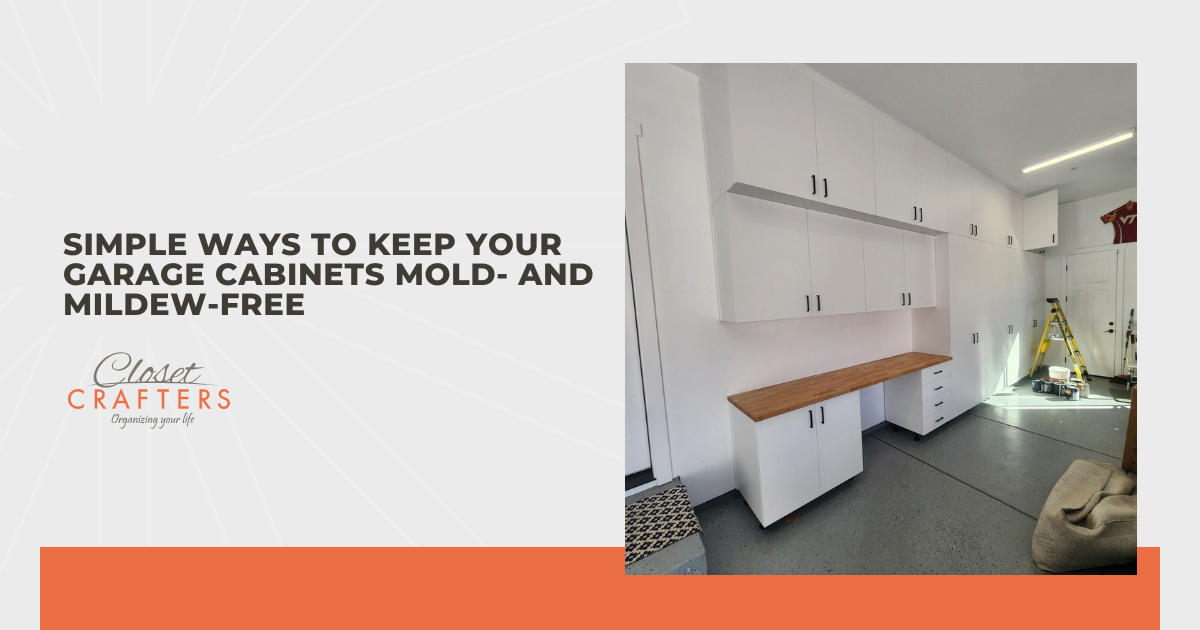Simple Ways to Keep Your Garage Cabinets Mold- and Mildew-Free

If you’ve spent any time in your garage during a hot or humid week, you know how quickly that space can turn from crisp and clean to stuffy and sour. Between temperature swings, poor airflow, and forgotten messes, garages are basically breeding grounds for mold and mildew, especially inside closed storage like garage cabinets.
I’m not talking about just a matter of gross smells or ugly stains. Mold can damage your garage cabinets, ruin the stuff you’ve stored, and even pose health risks if it goes unchecked. I’ve designed more garage storage systems than I can count and staying ahead of moisture makes a massive difference in how long those cabinets last and how nice it is to actually be in your garage.
Here’s how to keep your garage cabinets mold- and mildew-free for the long haul:
- Improve garage ventilation
- Control humidity levels
- Keep cabinets clean and dry
- Use protective liners and mats
- Seal and maintain cabinet surfaces
- Store items properly
- Inspect cabinets regularly
- Add natural freshness boosters
Don’t just close the cabinet doors and hope for the best. If you want to keep your garage cabinets mold-free and fresh, here’s what I’ve learned works best.
Improve Garage Ventilation
It all starts with air circulation. If your garage stays sealed up tight with no ventilation, moisture builds up and gets trapped, especially in and around cabinets. You might not even notice it at first. But give it a few weeks and you’ll start picking up on that sour, musty smell.
Even basic airflow makes a big difference. I always recommend people crack a window when possible or install small vents near the top and bottom of the garage walls. Better yet, run a fan for 30 minutes a day during warm seasons. If you’ve got two doors (say, a side entry and your garage door), open both for cross-ventilation. That breeze can dry out air pockets that mold would otherwise love to settle in.
My expert tip: Cross-ventilation is the easiest, cheapest way to prevent lingering humidity inside your cabinets.
Control Humidity Levels
If you live somewhere with sticky summers, or even just unpredictable weather, you need to monitor humidity. A basic digital hygrometer costs next to nothing and tells you what your relative humidity levels are. Aim for under 50 percent.
In my own garage, I keep a compact dehumidifier running from late spring to early fall. If that’s not in your budget or setup, moisture absorber packs or charcoal bags can help. They’re low-effort and easy to tuck into cabinet corners or hang discreetly on a hook nearby.
Keep Cabinets Clean and Dry
You can do everything else right, but if you're storing soggy rags, leaky garden gear, or sweaty tools inside your cabinets, mold will find you. I make it a point to wipe down the interior of my cabinets every couple of weeks, especially during humid months.
Dust and dirt may not seem like a big deal, but they hold moisture. And if you spill something (even just a splash of lawn chemical or sports drink), you have to clean it right away. Letting it sit is how musty smells start. I’ve learned that the hard way.
Never store anything damp. That includes rags, gloves, tarps, and pool toys. Let them dry completely before putting them back inside.
Use Protective Liners and Mats
Shelf liners give you a first line of defense. I use water-resistant rubber mats or textured vinyl liners on every flat cabinet surface. They’re especially useful under paint cans, gardening supplies, or anything that might leak. If you notice a liner feels damp or has a funky smell, toss it and replace it. They’re cheap and swapping them out is a lot easier than refinishing your cabinet shelves.
Seal and Maintain Cabinet Surfaces
Cabinet materials vary, but moisture affects them all over time. Wood cabinets especially need sealing, either with a moisture-resistant paint, clear polyurethane, or something as simple as furniture wax. Even metal cabinets should be protected with a rust-preventing finish or at least wiped with a light oil occasionally.
My expert tip: Do a visual inspection every season and touch up worn edges or scratches that could let moisture in. It’s 10 minutes of effort that can extend your cabinet life by years.
Store Items Properly
Think about what lives in your garage cabinets right now. Cardboard boxes? Old jackets? Extra holiday decorations? If any of that’s stored directly on the cabinet floor, or if the containers aren’t sealed, it’s asking for mold.
I always recommend plastic bins with tight-fitting lids for anything that’s sensitive to moisture. That includes paper goods, fabrics, old books, and seasonal gear. Keep heavy stuff off the cabinet base by using risers, milk crates, or low shelving to improve airflow underneath.
Inspect Cabinets Regularly
I make it a habit to check my cabinets at the start of every new season. It doesn’t take long. Open each door to sniff around and peek into corners and behind anything stored close to the back wall.
Look for small dark spots, fuzzy patches, or condensation on the inner surface. If you catch mold early, you can clean it up with vinegar or a mild cleaner before it gets out of control. If you ignore it, you’ll be looking at warped materials, damaged gear, and a much bigger cleanup.
Add Natural Freshness Boosters
Even in a clean, dry cabinet, odors can sneak in. A little added freshness goes a long way, especially when you’re using the garage as much as I do. I hang out there, work on projects, and even watch games sometimes. I want it to smell clean, not like a basement. Here are my go-to freshness boosters:
- Cedar Blocks These give off a subtle woodsy scent and naturally absorb moisture. I use them in drawers, tool cabinets, and anywhere I keep outdoor gear. Just sand them lightly every few months to refresh the aroma.
- Activated Charcoal Bags: These are excellent for odor and moisture control. I drop one in the back of each cabinet and hang a few in corners around the garage. They’re non-toxic and last for months.
- Baking Soda Jars: A small, open container of baking soda on each shelf works just like it does in your fridge. It neutralizes odor instead of covering it up. I swap mine out every couple of months and always notice the difference.
My expert tip: Label the date on each booster when you put it in, so you know when to replace it.
Conclusion
Keeping mold and mildew away from your garage cabinets doesn’t take a remodel, but it does require a little awareness and consistency. Between improved airflow, smart storage, and regular inspections, your cabinets can stay clean and fresh for years. This kind of upkeep might seem small, but trust me, it pays off. A few simple steps every season will protect your gear and your garage’s overall feel. Add it to your regular maintenance list, and you’ll never be surprised by a nasty smell or funky corner again.
Showroom Location
1824 Empire Industrial Ct
Santa Rosa, CA 95403
Contact Information
Phone: (707) 546-1009
Email: Contact@ClosetCrafters.com
Hours
Showroom & Office Hours
Monday - Friday: 9:00 AM - 5:30 PM
Saturday - Sunday: Closed - Please leave a message and we will get back to you upon our return to the office


